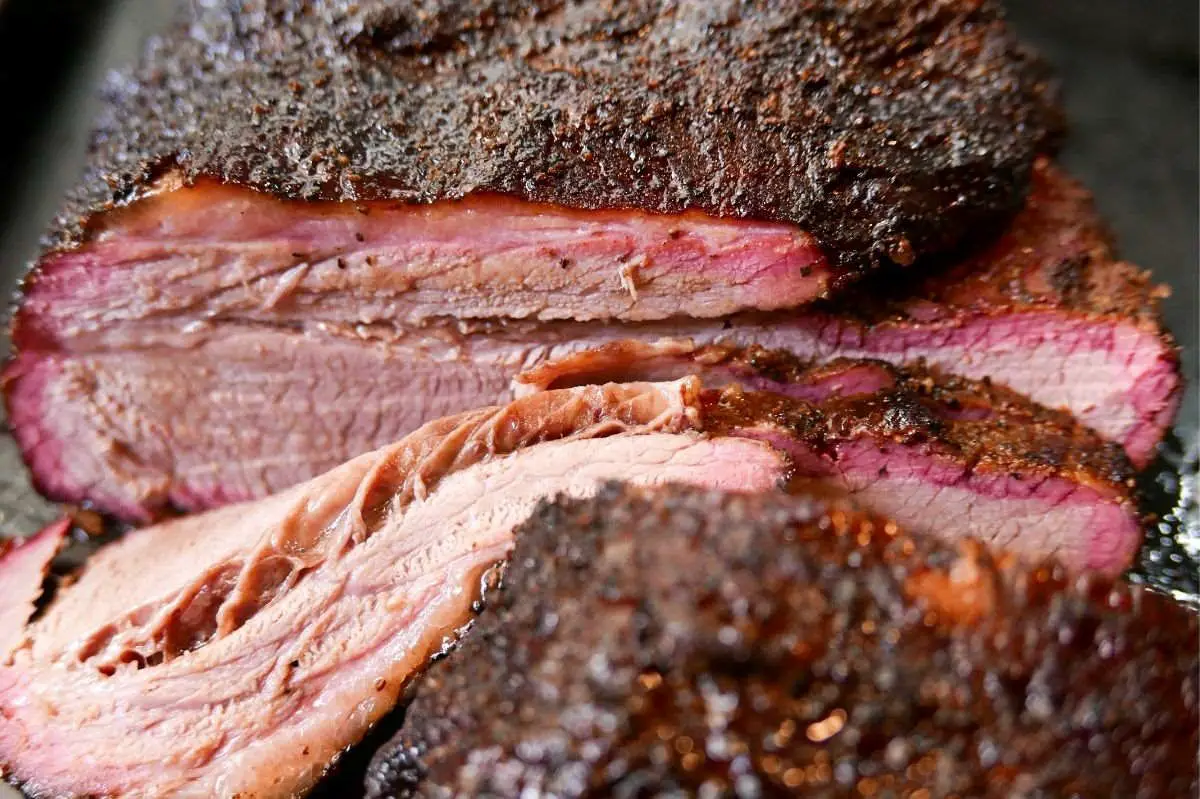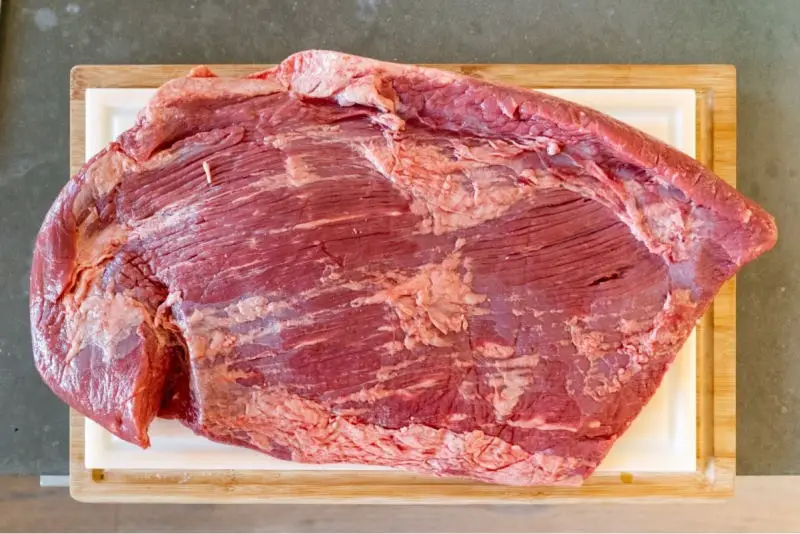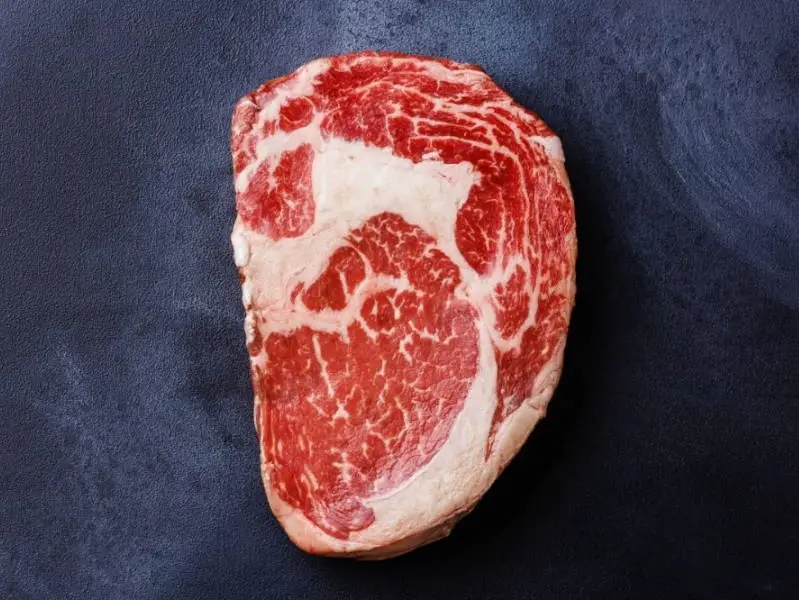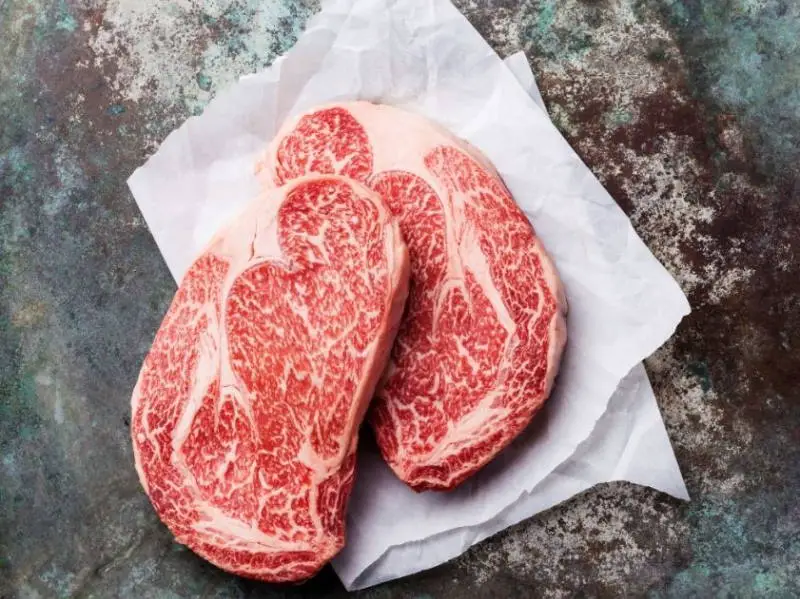
To determine the differences in cost between USDA Select, Choice, and Prime brisket, you have to compare their prices.
USDA Prime beef brisket – $5.39 per pound
USDA Choice beef brisket – $4.59 per pound
USDA Select beef brisket – $3.99 per pound
Source: Kroger stores PNW (2/1/2022)
As you may notice, USDA Select and Choice are similarly priced. USDA Prime meanwhile costs substantially more since it is a premium-grade beef.
A lot of Americans love BBQs and steaks. These great-tasting foods have come to define American cuisine, heritage, and tradition.
However, the taste of these well-loved foods depends largely on the quality or grade of beef. Prime beef can be quite expensive. Some might rethink buying prime beef due to its high cost. Do the taste and the quality justify the higher price point?

Does USDA Prime Taste Better Than USDA Choice?
Although USDA Prime indeed has excellent taste, it is not better than USDA Choice grass-fed beef. Some people think that the Choice grass-fed beef tastes better.
So is the high price of USDA Prime worth it? USDA Prime Beef is probably not worth the extra cost for most people.
Given the significant difference in price points, you would expect USDA Prime to score substantially higher in the taste department. It turns out that Choice is just as good and maybe better tasting for some people.
Bottom Line – USDA Choice will suit your palate just as well as USDA Prime, so don’t bother paying extra for Prime.
Comparing USDA Prime with USDA Choice
USDA Prime is said to be a better grade of beef than Choice. The quality rating depends on the age as well as the level of marbling in the beef. Marbling refers to fat. Thus beef with more marbling has higher fat content, which may render as the steak roasts.
The USDA carries out beef grading at the meatpacker’s request.
Fattier cuts of beef are perceived as more succulent and delicious. Ordered by quality (with highest on top), here are the three grades of USDA beef.
- Prime
- Choice
- Select
USDA Prime is the highest grade beef. It is characterized by its deep rich flavor and its tenderness. This can be attributed to the higher marbling or fat content.
USDA Prime can be somewhat rare and is not that easy to find compared to other beef grades. Consequently, it is frequently reserved for upscale restaurants and posh eateries.
If you find it in the supermarket, you will notice that it is being sold at a higher price point.
In general, younger beef cattle and higher marbling levels result in higher grades.
The flavor, juiciness, and tenderness depend on marbling. Beef from younger cattle tends to be more tender, juicier, and finer in texture.
USDA Choice – Second Best Beef Grade
USDA choice has less marbling and therefore is less tender. Due to lower marbling, it may have less juice and flavor.
USDA Select represents the lowest quality of beef steak in the supermarket. This beef grade tends to be tougher and leaner compared to the other two grades.
You can find USDA Canner and Cutter beef grades in convenience foods such as pot pies, microwave burritos, and other sorts of processed foods.
When you are out shopping for beef, you should be sure to check for the USDA emblem.
One trick that meat sellers use is to label beef as simply ‘Prime’ or ‘Choice.’ But if it does not have the USDA emblem, it is nothing more than a meaningless marketing gimmick.

How Does Prime Compare with Angus?
There is a lot of marketing hype surrounding Angus. But truth be told, it is not even a grade of beef in the first place. Instead, it is a breed. Like all other breeds, Angus can be great and not so great.
It depends mostly on the conditions under which the beef cattle were reared. Such factors as the cattle’s diet, conditions under which it grew, use of antibiotics and hormones can strongly influence Angus beef’s flavor.
Breeding and rearing animals under humane conditions are not just sales tactics. Nor is giving them high quality feed another sales ploy. Instead, these factors have a substantial effect on the flavor of the beef. Not only is the resultant meat healthier, but you can also rest assured that the cattle lived under good conditions before becoming your dinner.
Certified Angus Beef and the American Angus Association deal with Angus beef. They strive to provide services and programs that will improve the Angus breed’s genetics. Members of these associations have to pay a fee to continue their membership and to receive the latest news, updates, and developments.
These associations do not determine the grade of beef like the USDA. The beef has to fulfill just one requirement to get the Angus label. The cattle’s hide has to be a minimum of 51% black. So it’s just about the black color. As you can see, Angus is not necessarily a good grade of beef.
However, it is a great way of marketing beef. But that does not mean that Angus cannot be USDA certified and graded. Angus meatpackers can elect to get USDA certified and have their beef graded as either Prime, Choice, or Select.
The term ‘organic’ is also a great marketing tactic. When it comes to beef, organic means that the beef is free from pesticides, antibiotics, and external hormones. Do take note that grass-fed and organic means that neither soy nor grain was fed to the animal.
The best tasting and highest quality beef comes from animals that are grass-fed and raised organically. Grass-fed and organic are often used interchangeably. However, the two have very different meanings.
The term grass-fed implies that grass was fed to the animal instead of grains. Organic means that antibiotics and artificial hormones have not been administered to the cattle, nor have they been given food grown with pesticides.
Organic food also carries a higher price tag. Organic foods cost, on average, around 10 to 20 percent higher when compared to non-organic food.
How Many Beef Steaks Are Prime?
Around 2% of beef steaks earn the USDA Prime tag. One main reason for USDA Prime’s rarity is that only a small percentage of beef cattle are reared to qualify for this top grade. Prime grade beef is usually reserved for lavish establishments and specialty grocers.
As a result, you will be hard-pressed to find Prime grade beef in ordinary groceries and supermarkets.
How can you buy USDA Prime beef if you do not want to eat at an expensive restaurant? It would help if you tried shopping at the local meat market. You can also Google it online to find Prime beef for sale in your location.
Whole Foods and Costco are known to offer Prime beef to customers.
Since you will be paying top dollar for Prime, be sure to check up on the USDA emblem. If you cannot find the USDA shield, it means that the meat is not USDA Prime even though it may be labeled as such.
USDA Choice, on the other hand, is far more common. Around 70% of beef on the market carries the Choice label.
Read our article How to Prepare Steaks Using a Master-Built Electric Smoker
Finding USDA Prime Beef at Costco
Costco is one of the select retail outlets that have the USDA Prime beef up for sale. But you should note that they are not always transparent about the source of the beef. Not all meats labeled Prime are USDA Prime.
Costco says that it is committed to the humane treatment and welfare of animals used in its food products. Although Costco has expressed commitment towards animal welfare and treatment, it does not go much further than that.
On the other hand, Whole Foods Market has a far more comprehensive approach as manifested in the 5 Step Animal Welfare Rating system.
So if you want USDA Prime beef and be entirely sure that it was subjected to humane conditions and welfare, then Whole Foods Market is the better option for you.
Read our article Ten Top Dry Rubs for Smoking Beef

USDA Prime Compared to Wagyu Beef
Wagyu cattle are Japanese breeds that are reared in the United States as well as other countries. Wagyu is known for its heavy marbling. Wagyu is even more marbled than USDA Prime. Not only does Wagyu have greater marbling than USDA Prime, but it is also twice as expensive.
To maintain quality and flavor, Wagyu is heavily regulated and controlled. Stringent testing means that buyers will get to enjoy the highest quality of beef.
Wagyu is known for its unique texture and flavor.
American Wagyu also has Angus bloodlines so that the animals can better withstand local diseases and climates. As a result, American Wagyu is not heavily controlled, unlike Japanese Wagyu.
American Wagyu can carry around 30% fat on average. Thus, American Wagyu melts easily to give a sublime buttery flavor. It should come as no surprise that it is tastier and juicier than USDA Prime.
FAQ
Can you dry age USDA choice?
Yes, it is possible to dry-age USDA choice, and it can be a great option to consider. The meat will taste fantastic once you have done this, but it is worth noting that there can be potential issues with the texture of the meat. You may find that it is not as tender as you first thought it would be. However, this will depend on the cut of meat you are dry aging.
The process of dry-aging is fairly simple, and it helps to concentrate the cut of meat you have. This enhances the flavor of the meat and allows it to taste fantastic. Dry-aging when carried out correctly is perfectly safe to do, and you will save a lot of money by carrying out the process yourself.
The most important aspect to note is the cut of USDA choice you are going to use to dry age. This makes all of the difference when it comes to how good the meat will taste. The higher the quality of the USDA choice, the better.
The best choices to consider are strip loin, top butt, rib steak, prime rib, and boneless ribeye. These cuts will all have the best texture once they have gone through the dry-aging process.
Is USDA Choice brisket good?
When it comes to USDA Choice brisket, it is a great cut of meat to consider. While some people will prefer to use prime over choice, the difference is quite minimal. When looking at Choice brisket, it does feature less marbling.
Essentially, this means that the Choice cut of the meat features slightly less far in comparison to the Prime. While this can change the taste and the juiciness of the brisket, it does mean that the cut is slightly healthier than the Prime cut.
When cooking Choice brisket, it will still be full of flavor and juices. However, it is important that you follow the cooking guidelines closely, to ensure that you do not dry out the meat during cooking.
The best temperature to cook the brisket is around 250 degrees, if it is cooked at a temperature that is too high it can burn and dry out quickly. Once cooked, there is no real difference in the Prime and Choice briskets, and the Choice is still a great cut of meat to consider.
When choosing the USDA Choice Brisket, you should always aim for the highest possible quality. Inspect the meat before purchasing to determine whether or not it is a good cut.
How do I make USDA Select steak?
A Select steak is the best cut of steak to consume if you are on a diet. This is because it will contain the least amount of fat in comparison to Prime and Choice. While some people prefer their steaks to have some fat if it is something you always cut off anyway, select steak and the perfect option for you.
If you are new to cooking steaks, you may be unsure of how to cook Select steak. However, it is fairly easy to cook. It is worth noting that the cooking times will vary depending on how you prefer your steak to be cooked. The longer the steak is cooked for, the more well-done the Select steak will be.
Select steak is best cooked braised, rather than in a pan. This is because it can become tough quickly when it is broiled. To braise the meat, you will want to place the steaks in a hot pan and sear both sides on high heat.
After doing this, you will want to place a small amount of liquid over the meat, and carry on cooking it at a lower temperature until the inside of the meat is cooked to your personal preference.
Alternatively, Select steak can be grilled. However, the piece of meat should be marinated before cooking to ensure that it does not dry out while it is cooking.
Is USDA Prime grass-fed?
If you are choosing to purchase USDA Prime cuts of beef, this means that the meat is of a higher quality. As a result, people will often assume that this means that the cows are grass-fed. While this is the truth in some cases, it is not something that is guaranteed. In fact, the vast majority are fed grain.
This is something that tends to shock a lot of people, especially when you take into consideration that USDA Prime beef is more expensive to purchase. There are certain standards that are placed on meat.
Interestingly, if the USDA Prime beef was grass-fed, this can have a negative effect on the overall grading of the meat. This is because grass-fed beef is typically leaner and healthier. This means that the cuts have less marbling and fat.
The vast majority of USDA Prime beef is grain-fed because this helps to improve the marbling of the meat, and it helps to fatten the beef. It’s the marbling and intramuscular fat that make the USDA prime beef taste tender and juicy. Without it, the meat can become tough and dry fairly quickly when it is being cooked.
While grass-fed USDA beef tends to have a lower rating overall, this does not mean that the cut of meat is bad, which is what a lot of people assume. It simply means that the meat is not going to be as tender and juicy. If you are avoiding fatty meats, this can actually be a positive thing.
Is USDA Prime Better than Black Angus?
When it comes to USDA Prime and Black Angus cuts of meat, it is difficult to compare them fully. This is because USDA Prime is a classification of meat, and all types of beef can be put forward for classification.
It is a grading system that allows those purchasing meat to know the grade of meat they are purchasing. This is related to the tenderness and fat within the meat.
USDA Prime is a high-quality cut of meat that is great for grilling. It has a reasonable amount of marbling and is fairly juicy. If the cut of beef is the correct grading, it can be classed as USDA Prime, regardless of the breed of cow, it is from.
When looking at Black Angus, this cut of meat is taken from a specific breed of beef. This means that it does have its own distinctive taste. It is a great choice to consider that is juicy, and great for grilling.
Taking this into consideration, technically speaking, if a cut of Black Angus meets the correct requirements, it can be a USDA Prime cut. This is why they cannot really be compared. However, if Black Angus does not make the USDA Prime classification, then another cut of beef that does would be the better option to purchase.
Is American Wagyu better than USDA Prime?
It is a well-known fact that Wagyu beef is one of the best cuts of meat you can consume. It is perfectly tender and juicy. While American Wagyu is great, it does not compare to Japanese Wagyu.
When it comes to whether or not it is better than USDA Prime, to an extent this is entirely subjective. However, American Wagyu is far more expensive than USDA Prime, which does emphasize how great quality it is.
On the whole, American Wagyu does tend to be better. This is because it is very tender, and it is meat that features a lot of marbling. As discussed, it is this marbling that contributes to the tastes of the Wagyu.
The only downside to American Wagyu is its cost. It is significantly more expensive to purchase, and it is certainly something that you will only purchase on the odd occasion. As it is more expensive, extra care needs to be taken when cooking it, to ensure that it is not overcooked.
Check out our video on Smoking a Brisket
Check out our How to use a Masterbuilt Electric Smoker: A Beginners Guide
